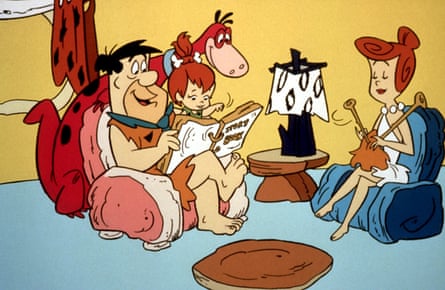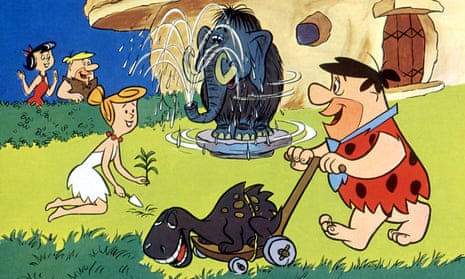Anyone who was a child in the 1970s onwards probably remembers The Flintstones as a Saturday morning cartoon staple, a yabba-dabba-doo time of prehistoric frolics and gleefully anachronistic dinosaurs. But when it initially aired 60 years ago, the adventures of Fred and Wilma, the titular Stone Age family, were aimed at adults. They are the direct ancestors of the golden age of adult-oriented animation we enjoy today.
When it was first broadcast on the ABC network on 30 September 1960, it went out at 8.30pm, after bedtime for most kids. It was the first prime time show from the studio set up by the creators of Tom and Jerry, William Hanna and Joseph Barbera, and they had spent months trying to convince the networks that an animation aimed at a grownup audience could work.
The Flintstones was an attempt to ape the hugely popular “Hi honey, I’m home!” type of 1950s domestic family sitcom typified by Jackie Gleason’s The Honeymooners. But Hanna-Barbera wanted to give it a twist, and a setting not limited by a two-room studio set. They went through various iterations, from the wild west to the Romans, but nothing stuck until one of the artists idly sketched two cavemen standing by a record player, with the pointed beak of an exotic bird acting as the needle on the stone disc. Hanna-Barbera had their concept, and after a couple of false starts on names – first, The Flagstones, then The Gladstones – they settled on The Flintstones.

The story is that once the pilot episode had been produced, the networks were immediately won over – so much so that in one test screening attended by several network bosses, there was a disheartening lack of laughter from the assembled executives, which Hanna and Barbera learned later was because no one wanted to give away to their rivals just how much they loved the show before the bidding began.
It was certainly a gamble to air a cartoon at 8.30pm, but it paid off, and The Flintstones proved amazingly popular. While we might now consider it just another of the slew of cartoons for children that emerged from the 60s, it dealt with very adult subject matter. It was only after its initial run that repeats became a kids TV staple.
“We watch The Flintstones today and you can see the lifestyle is clearly based on the postwar boom,” says Dr Steve Henderson, the director of the Manchester animation festival, which, because of the Covid pandemic, will this year take place online, from 15-30 November. “Wilma and Betty are constantly saying, “‘charge it!”, which was a very 60s thing with the rise of credit cards. And although there are all these jokes, such as the bird record player and the Brontosaurus crane at the quarry where Fred and Barney work, it’s essentially a portrait of a very aspirational modern family.”
It was so aspirational that sponsorship came from pharmaceutical companies, which marketed Flintstones vitamins, and, famously, the tobacco industry; in the ad breaks there were animated slots in which Fred and Barney would expound the taste and quality of Winston cigarettes.
Amid the puns and gags, serious – and sometimes dark – topics were explored. Henderson says: “The Flintstones was actually the first show to depict married couples sharing a bed, which wasn’t normal for TV at the time. And there are episodes where Barney and Betty discuss not being able to have kids, and when they eventually get baby Bamm-Bamm, they have to enter a custody battle.
“Fred has a gambling addiction and can be a horribly manipulative individual who will do anything to be able to go bowling.” Henderson says, too, that there was even an episode where Barney was going to kill himself. “He stood on a bridge with a rock tied to him and had to be talked down. And when you look at all that, you realise that this was not at all a kids’ show.”

While never reaching the popular heights of The Flintstones, more prime time shows followed from Hanna-Barbera, notably Top Cat and The Jetsons. It is not too much of a stretch to say that without Fred, Barney and co, we might not have had The Simpsons almost 30 years later and, from there, the adult animation that is prevalent today.
“While The Flintstones were the postwar boom family of the 1960s, The Simpsons were the nuclear, 2.4 children family of the late 1980s,” says Henderson. “And the success of that caused the networks to start demanding more shows centred on family life, and so we get Family Guy, American Dad! and Bob’s Burgers.”
In 2001, the cable network Adult Swim launched, becoming the night-time adult-oriented programming of the Cartoon Network. Cartoons for grownups thrived and the output became more surreal, rather than merely copying the 50s sitcom format. These days, animation is ruled by shows such as the reality-hopping Rick and Morty, the dysfunctional spy Archer and Bojack Horseman, in which a horse-headed former TV star languishes in a booze, drugs and sex-fuelled ennui.

Bojack Horseman was the first animated series from Netflix, and the rise of streaming services has raised the game in adult animation once again. We could be set for an even steeper rise in quality and output thanks, in part, to Covid. Henderson says: “Obviously, after The Flintstones and The Simpsons, everyone wants that success, but they have to do something differently, which is why we are seeing so much inventiveness. We are definitely living in a bit of a golden age for adult TV animation, and I think that’s going to increase. Coronavirus has changed the entertainment industry. While animated content has always been seen as the poor relation of live action, now people are seeing that you can make animation with several people sitting at home and you don’t need to get a load of people into a studio to make a show. So I think we’re going to be seeing a lot more quality animation coming out of this period.”
If Henderson is right, animation fans will definitely owe a debt to the bedrock from 60 years ago on which the current growth was built.
